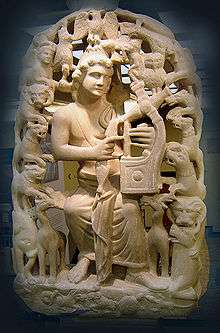Sirtaki
| Music of Greece | |
|---|---|
 | |
| General topics | |
| Genres | |
| Specific forms | |
| Media and performance | |
| Music awards |
|
| Music charts | |
| Music festivals | |
| Music media |
|
| Nationalistic and patriotic songs | |
| National anthem | "Hymn to Liberty" |
| Regional music | |
| Related areas | Cyprus, Pontus, Constantinople, South Italy |
| Regional styles |
|
Sirtaki or syrtaki[1] (Greek: συρτάκι) is a popular[2][3] dance of Greek origin, choreographed by Giorgos Provias for the 1964 film Zorba the Greek.[4] It is a recent Greek folkdance, and a mixture of the slow and fast rhythms of the hasapiko and hasaposerviko dance respectively. The dance and the accompanying music by Míkis Theodorakis are also called Zorbá's dance, Zorbas, or "the dance of Zorba".
The name sirtáki comes from the Greek word syrtos - from σύρω (τον χορό), which means "drag (or lead the dance)" -, a common name for a group of traditional Greek dances of so-called "dragging" style, as opposed to pidikhtos (πηδηχτός), a hopping or leaping style. Despite that, sirtaki incorporates both syrtos (in its slower part) and pidikhtós (in its faster part) elements.
Choreography
Sirtaki is danced in a line or circle formation with hands held on neighbours' shoulders. Line formation is more traditional. A similar choreography was featured in Just Dance 2015.
Meter is 4
4, tempo increasing, and often the signature is changed to 2/4 in the fastest part. Accordingly, the dance begins with slower, smoother actions, gradually transforming into faster, vivid ones, often including hops and leaps. The choreographer of the original unnamed dance was Giorgos Provias.[4]
Jean Vassilis (alias Jacques Suissa) added to the original choreography to promote the movie Zorba the Greek in France and named the dance Sirtaki.
Guinness World Records
On September 16, 2007, the world's longest chain of sirtaki dancers danced to the music of "Zorba the Greek" in Cyprus. The chain had a total of 268 members of eight groups dancing in step to "Zorbas." Ayia Napa Town Mayor Antonis Tsokkos said the aim of the event was to send the message that the village was interested in Greek culture and to promote the tourist resort abroad. Head of the cultural services of the Municipality Maria Tofini said that, according to Guinness World Records, the dancers had to perform in synchronized step for the attempt to qualify. The event drew the attention of tourists and locals, many of whom danced to "Zorbas" on the beach and in the sea.
On August 31, 2012, the Sirtaki Dance Guinness World Record was broken by 5,614 people dancing sirtaki for five minutes by the sea, starting from the port of the city of Volos in Greece. The Association for Social Impact and Culture to the Municipality of Magnisia organized the event on the main beach of the town of Volos under the light of the second full moon of the month. Some 5,614 people, aged from 14 to 89, danced to the music of Mikis Theodorakis' Zorba the Greek, filling the town square and making it into the Guinness World Records. Enthusiasts from Volos, Larisa, Athens, Thessaloniki, Trikala, and the Greek islands joined the regional union of blind people, the national synchronized swimming team and many ordinary citizens. The idea came from a Volos resident, Alexia Halvatzakou, who suggested it to the municipal services as an alternative way to promote the area. The President of the Association for Social Impact and Culture, Costas Halevas, liked the idea and set about organizing the event.
Zorba the Greek
It is rumoured that actor Anthony Quinn had injured his leg during the filming of the movie Zorba the Greek and could not perform the choreography planned for the final scene by choreographer Giorgos Provias. In order to film the scene, the choreography had to be changed on the spot to put minimal strain on his injured foot. It is also claimed that this is the reason for having a crane shot moving away from the protagonists at the end of the film.
See also
References
- ↑ Kate Armstrong; Michael Clark; Chris Deliso (2008). Greek islands. Footscray, Vic,: Lonely Planet. p. 49. ISBN 9781741043143.
- ↑ Tatossian, Anthony A. (2011). Villains and Lovers. AuthorHouse. p. 54. ISBN 9781456739812.
- ↑ Provost, P. Paul (2011). The Vagabonds. AuthorHouse. p. 192. ISBN 9781463428556.
- 1 2 Giorgos Provias on IMDb
| Wikimedia Commons has media related to Sirtaki. |